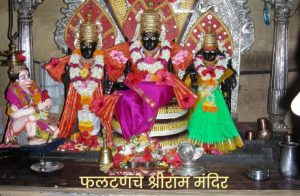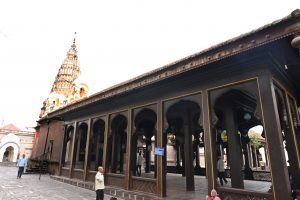Phaltan Taluka
Phaltan – Previously, this village was known for its abundant fruit cultivation. The name Phaltan is derived from “Phalstan” (place of fruits). The Naik Nimbalkar family of Phaltan is an ancient family dating back 750 to 800 years. Malojiraje and Shivajiraje were married to Dipabai and Saibai from this family, respectively. Shivaji Maharaj’s daughter was also married into this family, making it connected to the Maratha empire. The Shri Ram Temple in Phaltan is the pride of the city, and it is 225 years old. The temple is surrounded by a tall stone wall. Upon entering through the grand entrance, the royal palace is on the left and the Shri Ram Temple is on the right. The temple faces east and has three deep mala (lamp towers) in front. The idols of Ram, Laxman, and Sita in the sanctum are beautiful. The temple is built in the Hemadpanti style, and its spire and surroundings are very picturesque. Adjacent to Shri Ram Temple are the temples of Radhakrishna, Ekamukhi Datt, and Garuda. To the north is the Dattatreya Temple, built by Shrimant Mudhojirav Naik. There are also significant Jain temples and residences.



Jabareshwar Temple – A short distance from Shri Ram Temple, in the middle of the road, is the ancient Jabareshwar Temple. Built-in the Hemadpanti style, its sculptures and intricate carvings on stone are particularly noteworthy. The temple appears to be carved from a single massive stone. The pedestal in the sanctum is square and faces east. There are two shivalingas on the pedestal, which are uniquely shaped. Such a pedestal is rarely found elsewhere. Next to the entrance of the sanctum is a sculpture of a five-headed serpent and its two offspring. To the right, in niches, are idols of Vithoba-Rukmini, Nandi, a tortoise, and Ganesha. The enclosed assembly hall is circular.
Santoshgad – Also known as Kille Tathawada, Santoshgad is located 20 km from Phaltan. Though medium in size, the fort is strong and was built by Chhatrapati Shivaji Maharaj. Santoshgad has three levels to ascend. Upon reaching the first level, you arrive at a math (hermitage) where a sadhu welcomes visitors. Tourists can benefit from the preachings of the sadhu’s mother. Near the math are three caves, one
of which has a pond and an idol. Climbing the steep hill to the second level, you pass through two gates and see a Hanuman temple. At the third level of the fort is the citadel, where the temple of Tatoba Mahadev is worth seeing. The fort has many tunnels and caves, with ample water stored in the tunnel passages.
Sitamai’s Hill – It is believed by the local women that this is the location where the events of the Uttara Ramayana took place. The footprints of Sita, Lav-Kush, and Sage Valmiki are found here. This is the only place where you can see a temple dedicated solely to Sita. The rivers Manganga and Banganga originate from here.
Contact Details
Address: Phaltan Taluka



